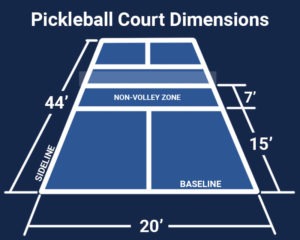High-Quality Pickleball Court Construction for each Degree of Play
High-Quality Pickleball Court Construction for each Degree of Play
Blog Article
Lasting Practices in Pickleball Court Building And Construction You Need To Know
As the appeal of pickleball continues to increase, so as well does the need for sustainable techniques in court construction. The effect of these techniques extends far past the court itself.
Picking Eco-Friendly Materials
Selecting eco-friendly materials is a critical action in the construction of sustainable pickleball courts. The choice of sustainable products not just lessens ecological effect however likewise enhances the longevity and performance of the court. Trick products consist of recycled rubber for the surface, which provides outstanding longevity and shock absorption while drawing away waste from garbage dumps.
Furthermore, utilizing locally sourced products lowers transport emissions and supports regional economic climates. Pickleball court construction. Utilizing native woods for fencing and seats can provide a lasting aesthetic while making certain durability versus the aspects.
Including permeable products for court foundations can additionally contribute to sustainability by permitting natural water drain and reducing runoff. These choices not only shield regional ecological communities however also promote much healthier play environments.
Effective Water Drainage Solutions
While the selection of environment-friendly materials is important, implementing efficient drain remedies is equally essential for maintaining lasting pickleball courts. Proper drainage not only protects the court surface from water damages yet also reduces erosion and overflow, promoting ecological integrity.
Effective drainage systems can consist of absorptive paving, which permits water to penetrate the ground instead of pooling externally. This minimizes the possibility of standing water, which can cause mold and mildew and other maintenance concerns. Furthermore, integrating tactically positioned drainage networks and swales can route excess water away from the court area, making sure a completely dry playing surface and protecting against dirt erosion.
Making use of native vegetation in the landscaping around the courts can better enhance water drainage by absorbing excess water and reducing runoff. These plants need much less irrigation and promote biodiversity, lining up with sustainable practices.
In addition, it is essential to frequently maintain the drain system to ensure its lasting efficiency. This consists of cleaning particles and tracking for blockages. By focusing on efficient water drainage solutions, pickleball court manufacturers can substantially contribute to the sustainability and durability of the center, eventually profiting both players and the setting.
Energy-Efficient Lighting Options
As the need for pickleball remains to grow, incorporating energy-efficient lighting alternatives into court layout has ended up being significantly crucial for sustainability. Conventional lights systems frequently take in excessive power, adding to greater operational costs and environmental effect. Taking on modern-day, energy-efficient modern technologies is essential for both brand-new constructions and renovations.
LED (Light Emitting Diode) lighting attracts attention as a top option because of its durability and energy financial savings (Pickleball court construction). Compared to conventional lighting, LEDs make use of around 75% less energy and can last approximately 25 times much longer, substantially decreasing maintenance costs. Furthermore, the directional nature of LED illumination minimizes light air pollution, making certain that illumination is focused on the court rather than bordering locations.

Lasting Surface Alternatives
Discovering sustainable surface choices for pickleball courts has obtained traction amongst gamers and contractors alike. The focus on environment-friendly products not only straightens with the growing environmental understanding however additionally improves the efficiency and durability of the courts.
One prominent alternative is the usage of recycled rubber, which can be sourced from utilized tires. This product provides exceptional shock absorption, decreasing the risk of injuries for gamers while promoting sustainability. In addition, modular ceramic tiles made from recycled plastics supply one more viable choice. These floor tiles are very easy to set up and replace, and their versatility permits for various court arrangements.
All-natural grass courts are likewise becoming a lasting option, advertising biodiversity and decreasing the heat island impact. Nonetheless, they require regular upkeep and water, which may not align with all sustainability goals.

Water Preservation Techniques

One more effective method involves the installment of rainwater harvesting systems. These systems save and gather rainwater for use in keeping court surfaces and landscape design. This strategy not just conserves potable water however additionally lowers dependence on municipal sources.
Moreover, utilizing drought-resistant landscape design around the courts is crucial. Native plants call for much less water and are better adapted to regional environment problems, therefore lowering overall water intake. In addition, utilizing efficient irrigation systems, such as drip irrigation, guarantees that water is supplied directly to plant roots, lessening evaporation and waste.
Final Thought
Including lasting practices in pickleball court construction considerably adds to ecological conservation and resource performance. Utilizing green products, implementing efficient water drainage services, and taking on energy-efficient illumination choices can greatly minimize eco-friendly effect. Exploring lasting surface area options and using water conservation methods improve the general sustainability of these recreational facilities. By prioritizing these methods, the building of pickleball courts can line up with wider environmental goals while promoting longevity and capability within areas.
As the popularity look at this website of pickleball proceeds to increase, so too does the demand for lasting practices in court building and construction.Picking green materials is a critical step in the building of sustainable pickleball courts. By prioritizing energy-efficient illumination choices, pickleball court fabricators can add to a much more lasting future while fulfilling the demands of gamers and stakeholders alike.Including lasting surface area alternatives not only enhances the performance of pickleball courts but additionally leads the way for executing reliable water conservation techniques.Incorporating sustainable practices in pickleball court construction considerably contributes to environmental preservation and resource performance.
Report this page